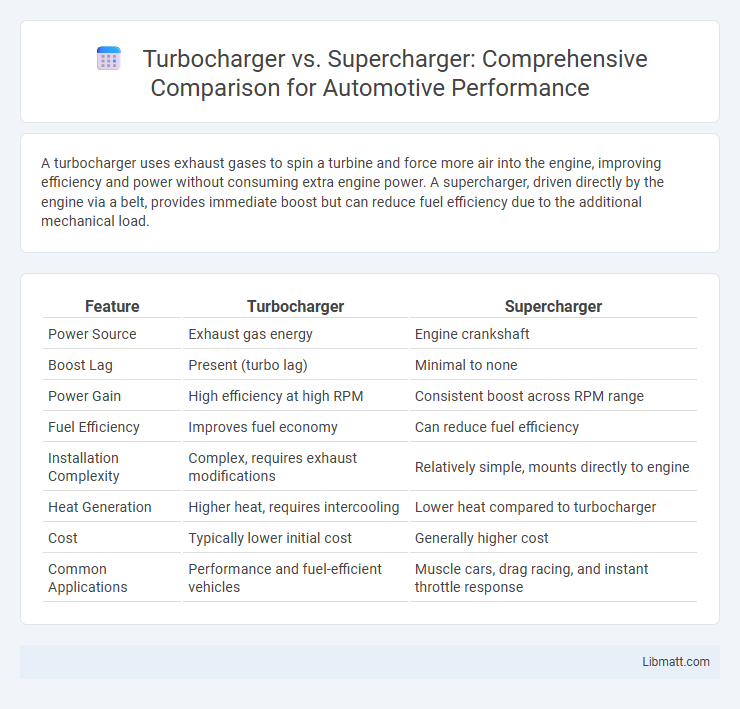A turbocharger uses exhaust gases to spin a turbine and force more air into the engine, improving efficiency and power without consuming extra engine power. A supercharger, driven directly by the engine via a belt, provides immediate boost but can reduce fuel efficiency due to the additional mechanical load.
Table of Comparison
| Feature | Turbocharger | Supercharger |
|---|---|---|
| Power Source | Exhaust gas energy | Engine crankshaft |
| Boost Lag | Present (turbo lag) | Minimal to none |
| Power Gain | High efficiency at high RPM | Consistent boost across RPM range |
| Fuel Efficiency | Improves fuel economy | Can reduce fuel efficiency |
| Installation Complexity | Complex, requires exhaust modifications | Relatively simple, mounts directly to engine |
| Heat Generation | Higher heat, requires intercooling | Lower heat compared to turbocharger |
| Cost | Typically lower initial cost | Generally higher cost |
| Common Applications | Performance and fuel-efficient vehicles | Muscle cars, drag racing, and instant throttle response |
Introduction to Forced Induction
Forced induction enhances engine performance by increasing the amount of air entering the combustion chamber, enabling higher power output and efficiency. Turbochargers use exhaust gases to spin a turbine that forces more air into the engine, improving fuel efficiency and power without direct engine load. Superchargers are mechanically driven by the engine's crankshaft, delivering immediate power boost at low RPMs but often at the cost of higher fuel consumption.
Understanding Turbochargers: How They Work
Turbochargers harness exhaust gas energy to spin a turbine connected to a compressor, which forces more air into the engine's intake manifold, boosting combustion efficiency and power output. This forced induction increases air density, allowing for more fuel combustion and significantly improving engine performance without increasing engine size. By effectively recycling waste exhaust energy, turbochargers enhance fuel economy while delivering substantial horsepower gains.
Superchargers Explained: Mechanisms and Types
Superchargers increase engine power by forcing more air into the combustion chamber using a belt-driven compressor connected directly to the engine crankshaft, which provides immediate boost without lag. The main types of superchargers include Roots, twin-screw, and centrifugal, each differing in design: Roots use intermeshing lobes to push air, twin-screw compress air internally between rotors, and centrifugal superchargers employ an impeller to accelerate air and increase pressure. Superchargers offer consistent and linear power delivery, making them ideal for applications requiring instant throttle response and increased low-end torque.
Performance Differences: Turbocharger vs Supercharger
Turbochargers harness exhaust gases to spin a turbine, boosting engine efficiency and delivering higher power output at elevated RPMs with minimal parasitic loss. Superchargers, driven directly by the engine's crankshaft, provide immediate throttle response and increased low-end torque but impose greater mechanical drag and fuel consumption. The choice between turbocharger and supercharger depends on desired performance characteristics: turbochargers excel in high-end performance and fuel economy, whereas superchargers offer instant power delivery and enhanced acceleration.
Power Delivery and Throttle Response
Turbochargers deliver power by utilizing exhaust gas energy, resulting in increased boost pressure primarily at higher RPMs, which can cause a slight lag in throttle response. Superchargers provide instant power delivery as they are mechanically driven by the engine's crankshaft, offering immediate boost and improved throttle responsiveness across the entire RPM range. The choice between these forced induction systems impacts engine efficiency, responsiveness, and overall performance depending on the desired driving characteristics.
Fuel Efficiency Comparison
Turbochargers improve fuel efficiency by utilizing exhaust gases to spin the turbine, which enhances engine power without additional fuel consumption. Superchargers are mechanically driven by the engine, which can increase fuel consumption as they draw power directly from the crankshaft. Studies show turbocharged engines typically achieve better miles per gallon (MPG) ratings compared to supercharged counterparts, making them more fuel-efficient in performance applications.
Installation Complexity and Cost
Turbochargers generally require more complex installation due to the need for precise exhaust manifold integration and additional cooling components, often increasing labor costs. Superchargers offer easier installation since they bolt directly onto the engine, resulting in lower labor time and expenses. While turbochargers tend to have higher initial costs, superchargers maintain a consistent price range with less complex mounting requirements.
Reliability and Maintenance Considerations
Turbochargers generally offer higher reliability due to fewer moving parts exposed to direct drivetrain stress, but they require careful maintenance of the exhaust system and regular oil changes to prevent bearing failure. Superchargers, while simpler in design with belt-driven mechanisms providing instant boost, tend to demand more frequent belt inspections and tightening to maintain optimal performance. Both systems benefit from routine checks, but turbochargers' sensitivity to heat and oil quality makes maintenance slightly more critical for long-term reliability.
Best Applications: Choosing the Right System
Turbochargers excel in applications requiring high efficiency and greater power output at high RPMs, making them ideal for performance engines and fuel-efficient vehicles. Superchargers provide immediate throttle response and consistent boost at low RPMs, making them better suited for muscle cars, off-road vehicles, and towing applications. Choosing between the two depends on specific performance needs, engine characteristics, and driving conditions.
Conclusion: Which Is Better for Your Needs?
Choosing between a turbocharger and a supercharger depends on your driving style and performance goals; turbochargers offer better fuel efficiency and increased power at higher RPMs by utilizing exhaust gases, while superchargers provide instant power delivery with engine-driven boost suitable for low-end torque. For daily driving and fuel economy, a turbocharger is often preferable, whereas superchargers excel in vehicles requiring immediate throttle response and consistent boost. Understanding these differences ensures selecting the optimal forced induction system tailored to your vehicle's performance demands.
Turbocharger vs Supercharger Infographic

 libmatt.com
libmatt.com